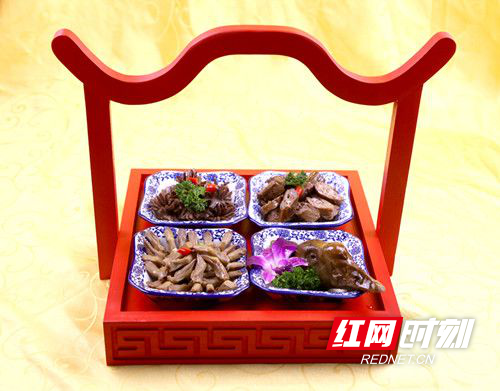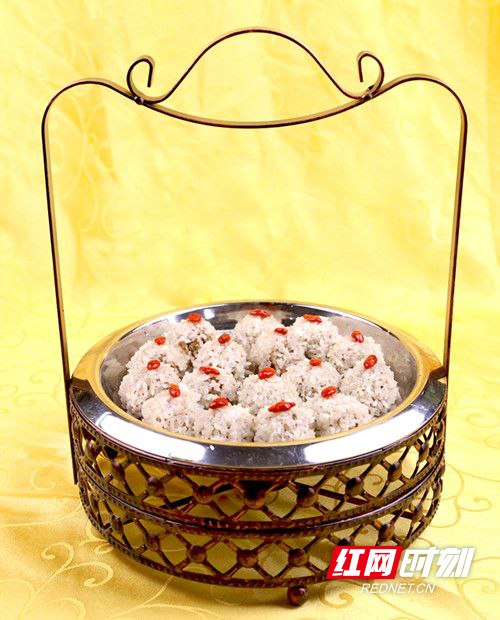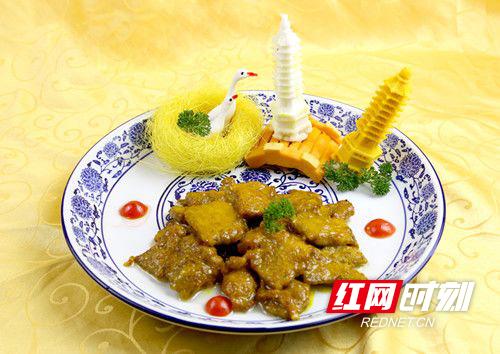Legend of Wugang Goose Banquet
2022-12-06

Four Treasures of Wugang Goose displays the essence and the charm of pot-stewed food. The meat from the head, neck and wing is delicate, and it will have a better texture after being marinated. After being marinated, goose tongue will be crisp and soft. Therefore, Four Treasures of Wugang Goose was regarded as the top classic of the Wugang Goose Banquet. In the 29th year during the reign of Emperor Jiajing in the Ming Dynasty, Zhu Yurong (the 6th king of Wugang) asked Emperor Jiajing to build a county palace. He presented Wugang Goose as tribute to the emperor and took a chef from Wugang to elaborate a table of the Wugang Goose Banquet. When the emperor tasted the goose, he couldn’t put down the four treasures.

At the end of the Ming Dynasty, Wugang City had a short history of being as an imperial city. In the 4th year of Emperor Shunzhi’s reign of the Qing Dynasty, Zhu Youlang relocated the capital to Wugang City under the hostage of Liu Chengyun and changed Wugang Prefecture to Fengtian Prefecture. It is rumored that Zhu Youlang’s mother came to Wugang City with him, and she fell in love with Wugang goose soup as soon as she ate it, which was regarded as the secret of health preservation. This soup is made of the tough goose which is raised for more than three years and simmered with American ginseng for five to six hours, and then seasoned with cooked goji berries, ginger slices, pepper, etc.

Snowflake Goose Ball is derived from “Xuan Feng Xue Ji”, one of the ten sights of Duliang. When Emperor Lizong of the Southern Song Dynasty served as defense envoy of Shaoyang and traveled to Wugang, he wrote the four big characters “Xuan Feng Xue Ji” in Xuanfeng Building. Fifteen years after Emperor Lizong’s death, the Southern Song Dynasty was destroyed by the Yuan Dynasty. In order to survive, his descendants changed their surname to Li and sneaked back to the Baoqing area to live in seclusion. It is said that in the early years of the Ming Dynasty, there was a descendant of Emperor Lizong named Li Fu, who had held an official position in the Wugang Prefecture Mansion. He was the first to inform a chef surnamed Li about the matter, who worked in a restaurant next to Xuanfeng Building. To commemorate the glory of his ancestors, Chef Li made this famous dish. This dish is made of goose breast minced into balls, wrapped in soaked fresh glutinous rice and steamed with goji berries. The goose is fresh, soft and delicious, making this dish a classic of the Wugang Goose Banquet.

According to records, a German girl named Si Botao came to Wugang with her father to preach in the 1930s. She fell in love with a guy. Helplessly, the situation was turbulent, and the two had to be apart. They were separated for more than half a century. Although the two were separated by oceans, they had been obsessed with each other. In the autumn of 1990, Ms. Si Botao, who had always been single, came to Wugang City from Germany and met her lover, when both of them were at their advanced age. Si Botao gave him two copies of the Bible and some photographs taken in Wugang that year, including the out-of-print photo of Sizhou Pagoda in Wugang City.

At the beginning, Si Botao was not used to eating Wugang cuisine, so she asked the chef to make lemon fried goose for her. Thus the guy also liked the lemon fried goose. After the two separated, the guy often asked the chef of the restaurant to make this dish specially, which could remind him of his beloved girl. Slowly, this dish gradually spread in Wugang.
The soup of this dish is slightly sour, sweet and aromatic. It is crisp on the outside and tender on the inside, full of petty bourgeois sentiment. To commemorate this cross-border romance, the third-generation catering inheritor of Wugang specially carved two pagodas as decorations when cooking this dish, making this dish boast more profound cultural connotation and become one of the classics of the Wugang Goose Banquet.


